Did you know that the humble pea soup has been around for ages and versions of it have been eaten by most civilizations and cultures around the world? The traditional pea soup is actually the split pea soup which is made from the dried legume and not the fresh/frozen green pea. It is believed that the Greeks and Romans even cultivated this legume as far back as 500 to 400 BC and the vendors sold hot pea soup on the streets of Athens.
In 19th-century English literature, pea soup is referred to as a simple food and eating it considered as a sign of poverty. In fact, in Thomas Hardy’s ‘Tess of the D’Urbervilles’ there is an extract where Tess remarks – “we have several proofs that we are D’Urbervilles… we have a very old silver spoon, round in the bowl like a little ladle, and marked with the same castle. But it is so worn that mother uses it to stir the pea-soup.” (sic – source Wikipedia). Up until the 20th century the split pea soup in London was called the London particular and was named after the yellow smogs for which London was infamous.
Soupe aux pois (jaunes) (yellow pea soup) is a traditional dish in Québec cuisine and is popular in Germany wherein the soup often contains meat such as bacon or sausage. Erwtensoep, also called snert, is the Dutch version of pea soup. It is a thick stew of green split peas, different cuts of pork, celery, onions, leeks, carrots and sometimes potato.
In Sweden the soup is called ärtsoppa. In Finland it is called hernekeitto. In both countries the soup is traditionally served with mustard. Consumption of pea soup in Sweden and Finland dates back to at least the 13th century, and is traditionally served on Thursdays. This is said to originate in the pre-reformation era, as preparation for fasting on Fridays (source – Wikipedia). In Denmark it is called gule ærter and in Norway it is known as ertesuppe. In Finland the soup is made of green peas. In Sweden and Denmark yellow peas are used. The Polish culture associates this soup with the military and it is a popular dish.
Nowadays, the abundance of fresh peas as an ingredient has led to greener version of this soup. My soup is one such version made with the most basic ingredients to give a lip-smacking recipe.
INGREDIENTS
- 2 cups fresh peas
- 3 cups vegetable broth/ water
- 2-3 cloves of garlic, minced
- 3-4 cloves
- 1 small sized potato, cut into cubes
- 2 tablespoons butter + a few drops of oil
- 1 small onion, chopped fine
- ¼ cup warm milk
- salt as required
- pepper powder as required
- 1 teaspoon thyme
For Garnishing
I like to add some pan fried peas to the soup as a garnish. But, you can add some cheese, cream or even bread croutons.
Note – whenever I cook with butter, I like to add a few drops of oil to the butter as it hits the hot pan. This prevents the butter from burning. My secret ingredient for his recipe is cloves. Trust me; it makes all the difference in the taste.
METHOD
- In a heavy bottomed pan add the butter and the oil. Once the butter is hot, tip in the garlic, cloves and onions. Sauté them till the onions turn pink and start to sweat.
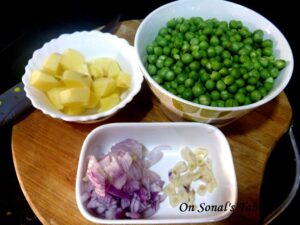

- Add the cubed potatoes and the salt. Sauté for 3-4 minutes.
- Add the broth/water and the thyme. Bring the solution to a boil and then reduce heat and cook for about 4-5 minutes.
- When the potatoes are almost 3/4th done, add the green peas. Cover the pan with a lid and let it simmer on low heat for about 8-10 minutes till the potatoes and peas are cooked.
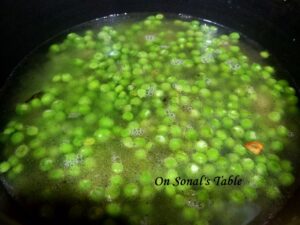
- Turn off the heat and allow the solution to cool before churning it in a blender. I prefer to use a blender because the cloves get liquidized easily.
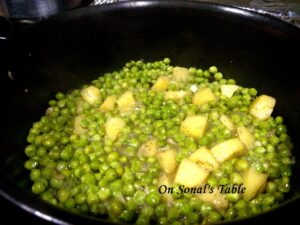
- Put the pureed solution (no need to run it through a sieve) back on the gas and allow it to thicken for about 2-3 minutes. Check for seasoning and add more salt if needed. Add the pepper powder at this stage and also the milk. Turn off the heat.

- Garnish with bread croutons or pan fried peas and add some freshly cracked pepper on top.
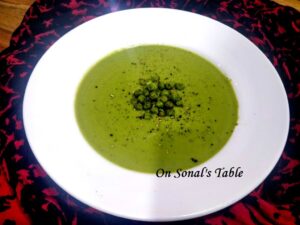
- Enjoy!
 Sonal Singh On Sonal's Table
Sonal Singh On Sonal's Table

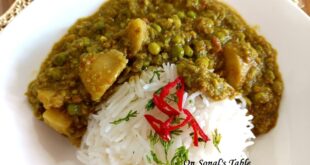
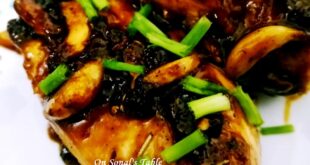

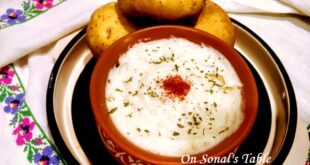
I am going to make your pea soup tonight because someone told me it was amazing! Thanks!
Thank you so much for taking the time out to write. I hope you enjoy the soup.